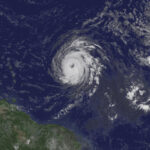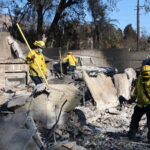A strong earthquake destroyed buildings and triggered landslides that buried dozens of houses, trapping residents, Monday in the central Philippines. At least 13 people were killed and 29 were missing.
The 6.8-magnitude quake, in a narrow strait just off Negros Island, caused a landslide in Guihulngan, a city of about 180,000 people in Negros Oriental province. As many as 30 houses were buried and at least 29 people were missing, Mayor Ernesto Reyes said.
“Their situation is bad because if you are covered by landslide for one hour, two hours, how can you breathe?” he said. “But we just hope for the best, that there are still survivors.”
Rescuers were using picks and shovels to dig for survivors, he said.
Reyes said at least 10 people were confirmed dead in his town, including students at a college and an elementary school and others in a market that collapsed. About 100 were injured.
The quake, which hit at 11:49 a.m. (0349 GMT), triggered another landslide in the mountain village of Solongon in La Libertad town, also in Negros Oriental. An unknown number of people were trapped, said La Libertad police chief inspector Eric Arrol Besario.
“We’re now getting shovels and chain saws to start a rescue because there were people trapped inside. Some of them were yelling for help earlier,” Besario told The Associated Press by phone. Three key bridges in the town cracked and were no longer passable, he said.
Philippine seismologists briefly issued a tsunami alert for the central islands. Huge waves washed out five bamboo and wooden cottages at a beach resort in La Libertad, but there were no reports of injuries, said police Superintendent Ernesto Tagle. Elsewhere along the coast, people rushed out of schools, malls and offices.
The epicenter was closest to Tayasan, a coastal town of about 32,000 people flanked by mountains in Negros Oriental province. Two died there, including a child when a concrete fence of a house collapsed, said Benito Ramos, head of the Office of Civil Defense.
Another child was killed in a church when a wall collapsed during a funeral in Negros Oriental’s Jimalalud town, Mayor Reynaldo Tuanda said.
Tayasan police officer Alfred Vicente Silvosa told AP by phone that aftershocks were preventing people from returning to their homes.
“We are outside, at the town plaza. We cannot inspect buildings yet because it’s dangerous,” Silvosa said. “I felt the building shaking, so I rushed out of the building. Our computers, shelves, plates, the cupboards, water dispenser all fell.”
A three-story office building also collapsed in La Libertad, but occupants escaped.
Negros Oriental police chief Edward Carranza said the temblor damaged many houses in Guihulngan and he ordered his men to help displaced residents find shelter.
Officials in some areas suspended work and canceled classes. Power and telecommunications were knocked out in several places.
Carranza said police rushed out of his building when the quake struck. “All my personnel ran out fearing our building would collapse,” he said.
“Now it’s shaking again,” he said as an aftershock hit. “My keychain is dancing.”
The U.S. Geological Survey said the quake was centered 44 miles (72 kilometers) north of Dumaguete city on Negros and hit at a depth of 29 miles (46 kilometers). The area is about 400 miles (650 kilometers) southeast of the capital, Manila.
The Philippines is in the Pacific “Ring of Fire” where earthquakes and volcanic activity are common. A 7.7-magnitude quake killed nearly 2,000 people in Luzon in 1990.
(Associated Press writers Teresa Cerojano and Hrvoje Hranjski contributed to this report.)
Was this article valuable?
Here are more articles you may enjoy.

 An Unusually Active Hurricane Season Is in Store for the Atlantic
An Unusually Active Hurricane Season Is in Store for the Atlantic  California Man Wins $50M in Lawsuit Over Burns From Starbucks Tea
California Man Wins $50M in Lawsuit Over Burns From Starbucks Tea  New Fire Maps Put Nearly 4M Californians in Hazardous Zones
New Fire Maps Put Nearly 4M Californians in Hazardous Zones  Deutsche Bank, Mudrick Sue Ambac Over $65 Million Transfer
Deutsche Bank, Mudrick Sue Ambac Over $65 Million Transfer 